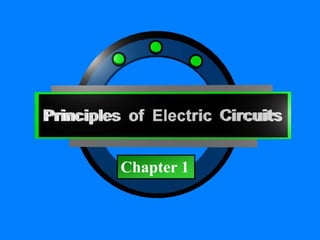
1# Chapter-1.ppt
- 1. Principles of Electric Circuits - Floyd © Copyright 2006 Prentice-Hall Chapter 1 Chapter 1
- 2. Principles of Electric Circuits - Floyd © Copyright 2006 Prentice-Hall Chapter 1 Welcome to the Principles of Electric Circuits. You will study important ideas that are used in electronics. You may already be familiar with a few of the important parts used in electronic circuits. Resistors are introduced in Chapter 2. •Resistors Color bands Resistance material (carbon composition) Insulation coating Leads Passive Components
- 3. Principles of Electric Circuits - Floyd © Copyright 2006 Prentice-Hall Chapter 1 Passive Components Summary •Capacitors Mica Foil Foil Mica Foil Foil Mica Foil Tantalum electrolytic capacitor (polarized) Mica capacitor_ A passive element is an electrical component that does not generate power, but instead dissipates, stores, and/or releases it
- 4. Principles of Electric Circuits - Floyd © Copyright 2006 Prentice-Hall Chapter 1 •Inductors stores energy in a magnetic field when electric current flows through it. Passive Components Summary
- 5. Principles of Electric Circuits - Floyd © Copyright 2006 Prentice-Hall Chapter 1 Passive Components Summary •Transformer is a passive electrical device that transfers electrical energy from one electrical circuit to another, or multiple circuits.
- 6. Principles of Electric Circuits - Floyd © Copyright 2006 Prentice-Hall Chapter 1 •Transistors Active Components •Integrated Circuits Summary An active component is an electronic component which supplies energy to a circuit. Transistor, semiconductor device for amplifying, controlling, and generating electrical signals.
- 7. Principles of Electric Circuits - Floyd © Copyright 2006 Prentice-Hall Chapter 1 Summary SI Fundamental Units length mass time electric current temperature luminous intensity amount of substance meter kilogram second ampere Kelvin candela mole m kg s A K cd mol Quantity Unit Symbol
- 8. Principles of Electric Circuits - Floyd © Copyright 2006 Prentice-Hall Chapter 1 Summary Some Important Electrical Units current charge voltage resistance power ampere coulomb volt ohm watt A C V W W Except for current, all electrical and magnetic units are derived from the fundamental units. Current is a fundamental unit. Quantity Unit Symbol
- 9. Principles of Electric Circuits - Floyd © Copyright 2006 Prentice-Hall Chapter 1 Summary Some Important Magnetic Units flux density magnetic flux magnetizing force magnetomotive force permeability tesla weber ampere-turns/meter ampere-turn webers/ampere-turns-meter ampere-turns/weber T Wb At/m At Wb/Atm At/Wb reluctance All magnetic units are derived from the fundamental units. Quantity Unit Symbol
- 10. Principles of Electric Circuits - Floyd © Copyright 2006 Prentice-Hall Chapter 1 Summary Very large and very small numbers are represented with scientific and engineering notation. Scientific and Engineering Notation 47,000,000 = 4.7 x 107 (Scientific Notation) 47,000,000 = 47. x 106 (Engineering Notation) To convert the number to engineering notation, we must move the decimal point from the end of the number to the left in groups of 3 places until there is at least 1 but no more than 3 digits to the left of the decimal point.
- 11. Principles of Electric Circuits - Floyd © Copyright 2006 Prentice-Hall Chapter 1 Summary 0.000 027 = 2.7 x 10-5 (Scientific Notation) = 27 x 10-6 (Engineering Notation) 0.605 = 6.05 x 10-1 (Scientific Notation) = 605 x 10-3 (Engineering Notation) Scientific and Engineering Notation
- 12. Principles of Electric Circuits - Floyd © Copyright 2006 Prentice-Hall Chapter 1 Summary Engineering Metric Prefixes peta tera giga mega kilo 1015 1012 109 106 103 P T G M k Can you name the prefixes and their meaning?
- 13. Principles of Electric Circuits - Floyd © Copyright 2006 Prentice-Hall Chapter 1 Summary Engineering Metric Prefixes 10-3 10-6 10-9 10-12 10-15 milli micro nano pico femto m m n p f Can you name the prefixes and their meaning?
- 14. Principles of Electric Circuits - Floyd © Copyright 2006 Prentice-Hall Chapter 1 Summary When converting from a larger unit to a smaller unit, move the decimal point to the right. Remember, a smaller unit means the number must be larger. Metric Conversions 0.47 MW = 470 kW 0.47 x 10^6 470 x 10 ^3 Smaller unit = 470 kW
- 15. Principles of Electric Circuits - Floyd © Copyright 2006 Prentice-Hall Chapter 1 Summary When converting from a smaller unit to a larger unit, move the decimal point to the left. Remember, a larger unit means the number must be smaller. Metric Conversions 10,000 pF = 0.01 mF Smaller number Larger unit
- 16. Principles of Electric Circuits - Floyd © Copyright 2006 Prentice-Hall Chapter 1 Summary When adding or subtracting numbers with a metric prefix, convert them to the same prefix first. Metric Arithmetic 10,000 W + 22 kW = 10,000 W + 22,000 W = 32,000 W = 32 k W Alternatively, 10 kW + 22 kW = 32 kW
- 17. Principles of Electric Circuits - Floyd © Copyright 2006 Prentice-Hall Chapter 1 Summary When adding or subtracting numbers with a metric prefix, convert them to the same prefix first. Metric Arithmetic 200 mA + 1.0 mA = 200 mA + 1,000 mA = 12,000 mA Alternatively, 0.200 mA + 1.0 mA = 1.2 mA
- 18. Principles of Electric Circuits - Floyd © Copyright 2006 Prentice-Hall Chapter 1 Engineering notation Exponent Metric prefix Scientific notation A system for representing any number as a one-, two-, or three-digit number times a power of ten with an exponent that is a multiple of three. The number to which a base is raised. A symbol that is used to replace the power of ten in numbers expressed in scientific or engineering notation. A system for representing any number as a number between 1 and 10 times a power of ten. Selected Key Terms